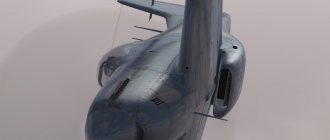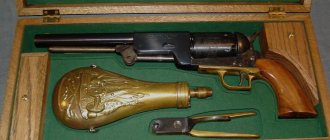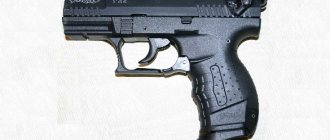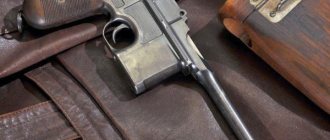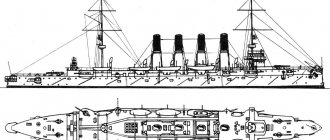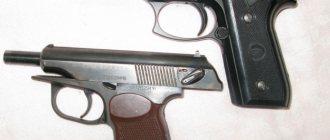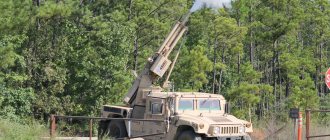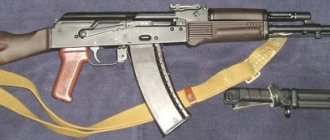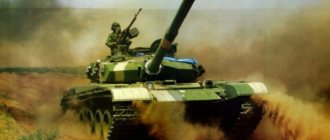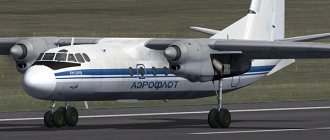When it comes to American bombers of the Second World War, strategic aviation aircraft come to mind first of all. This is partly justified, but on the whole, medium twin-engine bombers made no less of a contribution to the victory. These included the B-25 Mitchell, developed by .
Fate was not initially kind to this aircraft - it lost in the competition for a front-line attack aircraft, and as a medium bomber it was considered inferior to the B-26, which was developed in parallel. However, the Mitchells survived the entire war and were actively used even in the USSR.
History of creation
The US Army Air Corps announced a competition to create a front-line bomber capable of carrying up to half a ton of bombs in 1938. provided the NA-40 project - a twin-engine, two-fin high-wing aircraft. The crew initially consisted of three people. By the time the prototype was built, another pilot and a second gunner had been added. The pilots were seated in single file.
After the first flight in January 1939, the NA-40 immediately went to be rebuilt - the R-1830 engines were not powerful enough. With the R-2600 engines, it was possible to achieve the desired increase in performance, and the aircraft was sent for state tests. There, the NA-40 crashed while practicing landing on one engine, and the company lost the competition.
However, the project was not archived, and already in the spring of 1939 they began to remake it to meet the new technical specifications - into a medium bomber.
The bomb bay had to be enlarged, and the pilots were seated side by side. The military became interested in the project and adopted the aircraft even before the prototypes were built. The bomber was designated B-25 and named "Mitchell" in honor of one of the pioneers of bomber aviation.
In art and popular culture
- The B-25 plays a prominent role in Lyle Gavin's novel "Heat Script"
- The B-25 is mentioned in Joseph Heller's novel Catch 22, and in the film adaptation of the novel, 18 aircraft were filmed, for which there was enough money in the film's budget (1 (faulty) was burned during the crash scene, and 17 took off in the frame).
- The B-25 bomber is also mentioned in the film Pearl Harbor in the second half of the film. Doolittle's squadron flies to bomb Tokyo, taking off directly from the deck of an aircraft carrier.
- The B-25 can be seen in the film "" by Steven Spielberg.
- B-25 can be seen in the movie “Forever Young”
- The B-25 can be seen in the movie Sucker Punch
- The B-25 can be seen in the film "Thirty Seconds Over Tokyo"
- In the movie Hanover Street, Harrison Ford's character is a B-25 pilot who is shot down over France during one of his missions.
- The aircraft can be seen in the game IL-2 Sturmovik in three modifications and War Thunder in five modifications (3 modifications of B-25, 2 modifications of PBJ-1). The bomber has excellent defensive weapons, good armor and a large bomb load.
- There is a modification for the BeamNG.drive game that adds the B-25 Mitchell to the game. The author of the add-on is one of the leading developers of the game, known under the nickname “B-25Mitch”. The plane has realistic control physics, destruction, and thermal physics. Through the parts selector, you can add an ammunition load of four bombs, which can be dropped through the hatch.
Modifications
A batch of 24 aircraft under the designation B-25 became, in fact, pre-production. It was collected from mid-1940 to early 1941. The next series - B-25A - absorbed the experience of the outbreak of war. Armor protection for the crew was installed, and the Mitchell's fuel tanks became protected. This series was also small - only 40 bombers.
The B-25B series aircraft received enhanced weapons. Initially, the B-25 was equipped with a 12.7 mm machine gun in the tail, a 7.62 mm machine gun in the bombardier's cabin, and three more in the sides and under the bottom. The tail installation was abolished, but two - lower and upper - turrets with a pair of large-caliber Brownings were introduced.
The turrets were equipped with electric drives; the lower turret moved into the fuselage during flight and was controlled remotely. 119 Mitchells with enhanced armament were produced, and two dozen B-25s were sent to Britain.
The appearance of armor, protected tanks and new machine guns on the B-25 increased the weight of the aircraft and worsened its flight characteristics.
Therefore, the B-25C that went into production in 1942 was equipped with uprated R-2600-13 engines, and the volume of gas tanks was increased.
The Mitchells began to be standardly equipped with an autopilot and an anti-icing system, and the bomb bay was reconfigured. This series of "Mitchells" became the first truly mass-produced and was actively exported to Britain, the USSR, China and the Dutch East Indies.
As production progressed, the bomber's equipment changed - external bomb racks were installed, the bombardier's machine gun was replaced with a large-caliber one, and another Browning was installed as a course gun. The B-25D, although considered a separate series, differed from the “C” modification Mitchells mainly in the assembly location. They were produced by a government plant in Kansas City. The rear machine gun mount on the B-25 was subsequently returned.
The bomber variants, designated "E" and "F", remained experimental, with the final version becoming the B-25J. The main difference was that the nose of the aircraft was made in the form of a module, which could be replaced with a section without a bombardier's cabin, but with eight 12.7mm machine guns.
External bomb racks were modified so that the Mitchell could carry unguided missiles. More than four thousand of these aircraft were produced, and 800 were left in the original version.
The "specialized" B-25 attack aircraft of the "G" and "H" series stood out in that their offensive weapons were enhanced by the installation of a 75mm gun. The Mitchells of the “G” series were equipped with an M4 cannon, basically similar to tank ones; the next series received a lightweight version of the M5. At the same time, the plane lost its co-pilot - he was replaced by a loader. In addition to the cannon, the Mitchell assault weapon included six 12.7mm machine guns.
On the basis of ten "Mitchells" reconnaissance aircraft were built for aerial photography.
They were called F-10. The B-25 bombers operated by the Navy were designated PBJ-1 and were often equipped with radar.
Medium bomber B-25C (D) "Mitchell".
Medium bomber B-25C (D) "Mitchell".
Developer: North American Country: USA First flight: 1941
On September 28, 1940, USAAC command ordered NAA to prepare for large-scale production of B-25 bombers. The design of the aircraft should have taken into account the experience of the war in Europe. The result was the B-25C and B-25D modifications, which were produced by plants in Inglewood and Kansas City, respectively. Both modifications were almost identical, differing from each other only in minor details.
In January 1942, the Inglewood plant switched to producing B-25C modifications. This type, designated NA-82, was developed back in September 1940 and the first order was issued for it at the same time. Externally, the first modification C aircraft did not differ from their predecessors. The main feature of the B-25C aircraft was the new Wright "Cyclone" R-2600-13 engines with a power of 1700 hp / 1275 kW, equipped with Holley 1685HA carburetors. The wing consoles were strengthened. The electrical network was switched to 24V. The volume of gas tanks in the wing has increased significantly, while the possibility of installing an additional tank in the bomb bay has remained. New, more powerful and more reliable high-pressure hydraulic brakes appeared on the wheels.
B-25C bomber.
B-25C bomber.
B-25C bomber.
B-25C instrument panel.
USAAF B-25C projections. Drawing.
The list of standard equipment has been supplemented with an autopilot. An important innovation was the anti-fouling system. It consisted of liquid and pneumatic devices. The propeller blades were washed with a liquid (alcohol mixture), which was driven from the tank by an electric motor. The pneumatic deicer included rubber pads on the leading edges of the wing and tail. If necessary, compressed air was supplied to their internal cavities. The pressure pulsated and the pad “breathed,” breaking the ice crust. Cabin heating with Stuart-Warner gasoline heaters was also introduced. All this made it easier to operate aircraft in cold climates. The bomb bay was expanded and reconfigured. At the same time, the total bomb load has not changed, but the capabilities for suspending various types of ammunition have increased significantly.
The first contract was signed on September 24, 1940 for the construction of 863 B-25C aircraft (factory designation NA-82). The first B-25C (41-12434) took off on November 9, 1941. The plane was piloted by the company's test pilot Edward Virgin. A total of 1,620 aircraft of this modification were built. Modification C was the first to be produced in mass quantities. During serial production, the aircraft was gradually improved. Starting with the 384th bomber (41-12817), the transparent window above the navigator's position was replaced with a convex blister. This made it easier to navigate the sun and stars. At the same time, the fuel supply was increased and dust filters were introduced on the suction pipes of the engine carburetors. The aircraft was equipped with modified Bendix Amplidyne turrets.
From the 606th vehicle (41-13039) came the S-1 series, which differed in bomb armament. In addition to the internal one, an external bomb suspension was installed on it. Four beams were placed under each wing, designed to carry bombs with a caliber of up to 113 kg. Thus, for short distances, due to a smaller fuel supply, it was possible to take a significantly larger bomb load, reaching up to 2360 kg. The B-25S-1 could also carry a shortened aircraft torpedo suspended under the fuselage. In this case, bombs were not taken, and an additional gas tank took up space in the bomb bay. In total, the plant produced 258 B-25S-1.
On the S-5 series, small arms were again strengthened: - the bombardier’s 7.62-mm machine gun was replaced with a large-caliber (12.7-mm) machine gun with 300 rounds of ammunition; — a fixed 12.7 mm machine gun with the same reserve was additionally installed on the right side of the front cabin. Now the bombardier could not be distracted on the combat course - the pilot, who had a collimator sight, was firing from a stationary machine gun. Finger-type flame arresters were installed on the exhaust pipes of the manifolds. Their pipe branched at the end, forming a structure that truly resembled the hand of a human hand. In operation, they performed poorly, often cracked, and on almost all machines they were replaced with old-type pipes. From October to December 1942, the Inglewood plant produced 162 B-25S-5s.
Bomber B-25C-5.
Bomber B-25C-5.
B-25C-5 bombers.
The S-10 series differed little from the S-5 - only in its adaptability to use in cold climates and new AM type compasses. The last aircraft of the series (42-32383) became the prototype for the B-25S-15. On the C-15 series, which went into production in January 1943, the common exhaust manifolds were replaced by individual pipes for each cylinder, equipped with flame arresters. This made it much easier to fly the plane at night, when flames and sparks from the exhaust blinded the pilots in the dark. The new design turned out to be much more reliable than the old “finger” flame arresters and was retained in all subsequent series and modifications. The new exhaust system was designated Clayton "S". The aircraft was also equipped with an emergency landing gear release system. Instead of a 7.62 mm machine gun in the frontal fairing, on the S-15 series, two 12.7 mm machine guns were installed. One of them was rigidly fixed with the muzzle forward, and the other could be aimed.
Soviet pilots near a B-25C-15 bomber of the USSR Air Force, winter 1943.
The nose of a B-25C-15 with two 12.7 mm machine guns.
B-25C-15. Scheme.
The B-25S-20, although redesignated NA-96 at the factory, was almost identical to the S-15. Starting with aircraft No. 42-64702, forward visibility from the pilot's seats has been improved due to a reduction in the number of bindings in the canopy. In addition, an additional 215 gallon (814 L) self-sealing fuel tank was installed in the bomb bay.
On the B-25S-25, several options for an additional tank in the bomb bay were introduced: a protected one for combat operations and a larger capacity ferry tank without a protector (it was attached to every second aircraft). At the same time, a new cockpit canopy was introduced.
The production of bombers of the B-25C modification in Inglewood ceased in May 1943. In total, 1619 copies were collected. The early B-25S, due to their higher thrust-to-weight ratio, were slightly faster than the B-25B, but gradually an increase in weight and an increase in drag (external suspension affected) led to a decrease in speed and a deterioration in the rate of climb.
In parallel with the B-25C, an almost identical modification, the B-25D, was produced. On June 28, 1941, a contract was signed for the production of 1,200 B-25D (NA-87) bombers. The first two vehicles of this modification were ready at the beginning of 1942. One of them made a test flight on January 3, piloted by Paul Balfour. After a month of test flights, serial production began. The B-25D aircraft were entirely manufactured by the NAA branch in Kansas City and.
B-25D bomber.
B-25D bomber.
USAAF B-25D Mitchell. Drawing.
The first six bombers were almost completely assembled in Inglewood and transported to Kansas City in large units. Two of them were delivered to the Air Force in February 1942 and three more in March. Until the hundredth aircraft, all parts came from the main plant, and only assembly and adjustment were carried out in Kansas City. From the 101st car, some of the components began to be supplied by former automobile ones, and the center section and some other things began to be manufactured on site.
From the 201st bomber in Kansas City, they switched to the D-1 series, which received external bomb racks, an astronavigation blister, self-sealing gas tanks in the center section, self-sealing oil tanks and pressurized air filters, and began using Bendix Amplidyne turrets. A suspension for a torpedo was installed under the fuselage, and starting with copy No. 41-30352, “finger” flame arresters were installed on the exhaust pipes.
Bomber B-25D-1.
Bomber B-25D-1.
Bomber B-25D-1.
On the D-5 series, the protection of the front hemisphere of the aircraft was strengthened. Instead of a 7.62 mm machine gun, three 12.7 mm machine guns were installed - two stationary and one with the ability to aim. The bomb sight was improved, and beginning with 41-30532, every third vehicle featured a 585-gallon (2,145 L) jettisonable fuel tank in the bomb bay. Starting with model No. 41-30057, the aircraft received enhanced heating for the cockpit.
USSR Air Force B-25D-5 bomber.
The D-10 was similar to the S-10; aircraft of this series were adapted for operation in the far north. Like the S-10, they were equipped with an AM compass and an emergency landing gear system. The next series of B-25D-15s were equipped with a Clayton "S" type exhaust system. On machines of the D-1 - D-10 series, “finger” flame arresters were mounted. On the D-15 they were replaced with individual exhaust pipes.
On the B-25D-20 (the series began with copy No. 41-30533), which received a different cockpit canopy and new gas tanks in the bomb bay, the original order for modification D ended. Under an additional contract, the D-25, D-30 and D-35 series were produced (factory designation NA-100). They have been going since July 1943. The B-25D-25 differed from the previous series aircraft only in the introduction of a portable oxygen kit. But the next two series were already closer to the next mass modification - the B-25J, and had a completely different configuration of defensive weapons. On these machines the lower exhaust tower was removed. The place of the tail cone was taken by a firing point with a 12.7 mm machine gun, but not the same as on the B-25A. The shooter was sitting in it, not lying down. Large windows were cut into the sides behind the wing, from which the barrels of two more heavy machine guns looked out. Some aircraft received a second fixed machine gun in the bombardier's cockpit. The D-30 series was additionally distinguished by heated cockpit windshields. The last B-25D Mitchell left the Kansas City factory in March 1944.
Bomber B-25D-25.
B-25D-25 and B-25D-30. Scheme.
B-25s of various modifications were supplied to American naval aviation - a total of 706 vehicles, designated PBJ-1. The modification index usually corresponded to the army one. So, the B-25C turned into the PBJ-1C. There were two exceptions: the B-25B was simply called PBJ-1, and the PBJ-1G was a torpedo bomber based on the B-25C or B-25D (the B-25G was not supplied to naval aviation). The 50 B-25C aircraft transferred to the US Navy were designated PBJ-1C. In turn, the 152 B-25Ds delivered to the fleet became designated PBJ-1Ds. Many of them have undergone alterations. The aircraft were equipped with AN/APS-2 or -3 radars, as well as the LORAN (Long-Range Aid to Navigation) navigation system. A battery of three 12.7-mm machine guns was installed in the bow, and two more machine guns were installed on the sides of the fuselage. The modified bomb bay could carry mines. The external sling could carry a torpedo or ten unguided HVAR missiles of 127 mm caliber. The standard bomb load was 907 kg. Under the wings, on an external sling, the aircraft could carry another 1,000 pounds (454 kg) of bombs.
PBJ-1C from squadron VMB-612. The vehicle carries an AN/APS-3 radar and two HVAR missiles.
Of the aircraft built for the US Army Air Forces, a number of B-25Cs and B-25Ds were sent to Great Britain, the Soviet Union, Canada and Brazil. The British received 167 B-25C and 371 B-25D, designating them “Mitchell” Mk.II. The Canadians received four aircraft, the Brazilians - 29. Intended for the USSR, the first 72 B-25C aircraft arrived in Iran in March 1942.
In April 1942, the first three (according to other sources - four) B-25Cs were transferred to the 37th Bomber Regiment under Lieutenant Colonel Katarzyn. This unit was transferred from the Far East to the Monino airfield near Moscow. Specialists from the Air Force Research Institute (who transported the vehicles from Basra) and the Bureau of New Equipment from TsAGI helped study the new equipment. One plane was disassembled for better inspection. Some members of M.M. Gromov's group who studied the B-25 in the USA - pilots, navigators, engineers - were transferred to the regiment. In June 1942, one B-25S underwent a full program of state tests at the Air Force Research Institute, receiving fairly good reviews.
Bomber B-25C being tested at the Air Force Research Institute, June 1942.
The bombers that arrived at Monino underwent re-equipment, since the Americans’ crew included a separate bombardier (in the bow cockpit) and a separate navigator sitting behind the pilots. For us, both functions were combined by a navigator, and for him all navigation instruments were transferred to the bow. The outdated Wimperis bomb sight was removed and replaced with the domestic OPB-1. To increase combat survivability, a system for pressurizing the tanks with neutral gas was introduced. Plant No. 156 in Moscow and the Air Force repair base in Monino were involved in converting the vehicles.
USSR Air Force B-25S bomber.
By the end of the spring of 1942, three regiments (37th, 125th and 16th) as part of the 222nd division, which, in turn, became part of the 1st Army of General V.A., had already been re-equipped with Mitchells. .Sudtsa. But this army did not reach the front. Her units were sent separately to different places. The 222nd Division was transferred to the Western Front. The 37th regiment began fighting in July, the 16th in August, and the 125th in September. Bombers operated near Vyazma, Dorogobuzh, and Yartsevo. Many daylight sorties were made by single aircraft and small groups without fighter cover. The targets were automobile and tank columns and fortified positions.
Almost immediately, a strange defect emerged - the “slipping” of the aircraft’s soft gas tanks. It turned out that Soviet gasoline 4B-78, rich in aromatic hydrocarbon impurities, quickly destroys the inner layers of rubber. Already on October 5, by order of the chief engineer of the Air Force, the B-25 was switched to imported B-100 gasoline. Most of this fuel came from the United States in cans, and the ground crew struggled to empty the contents of these small containers into tankers. But the corrosion of the tanks has stopped.
The Mitchells did not work in front-line aviation for long. At low altitudes, the rather bulky B-25 behaved inertly and presented a good target for German anti-aircraft gunners. Losses began to mount. As a result, they came to the conclusion that the use of the B-25 for tactical purposes is ineffective. In addition, problems arose due to a shortage of spare parts. For example, in September, a fairly significant number of bombers were idle waiting to receive new wheels.
On September 29, 1942, the 222nd Division was officially transferred to Long Range Aviation (LAR). Such use of these aircraft on the Soviet-German front was quite logical. For the role of a front-line bomber, the Pe-2 and A-20 were much better suited for us, and in the ADD it was possible to fully use the large range of the B-25, and excellent navigation radio equipment, and powerful weapons, and a significant bomb load. The number of B-25s sent to the ADD was constantly increasing. If in 1942 it received only 16 aircraft of this type, then in 1943 - 129, in 1944 - 210, and by May 1, 1945, the 18th Air Army, into which the ADD was transformed, received another 128 aircraft.
The Mitchells began making long-distance night raids behind enemy lines. As of November 18, the 222nd Division had 68 B-25 aircraft in its fleet. To increase the range, specially designed horseshoe-shaped additional gas tanks were installed in the bomb bay. They were used for maximum range flights. The bombs were placed on an external sling under the wing (usually two FAB-250 slings weighing 250 kg each). Then at plant No. 156 they mastered the production of cardboard disposable hanging tanks. For night bombing, special NKPB-7 sights were mounted on aircraft.
In the fall of 1942, at the first frost, we were faced with massive failures of units, instruments, and weapons. The reason turned out to be insufficient frost resistance of the hydraulic system hoses. Oil cooler ruptures appeared. But these problems were dealt with quite quickly. Plant No. 81 designed and manufactured samples of removable winter windshields for engine hoods. They had sector slots that opened or closed as needed. All Soviet aircraft with air-cooled engines, as well as imported ones, in particular, Douglas A-20 bombers, were equipped with similar devices.
Since the end of 1942, most of the bombers arrived from America along ALSIB, a ferry route from Alaska through Chukotka and Eastern Siberia to Krasnoyarsk. By the end of 1942, no more than a dozen Mitchells were accepted in Fairbanks, but the next year there were much more of them, about 10-20 cars per month. The peak was observed in September 1943 - 26 bombers flew from Fairbanks to Krasnoyarsk.
Following the B-25C, B-25D began to arrive. In the later series of this modification, they switched to a more rational arrangement of defensive weapons, getting rid of the unreliable retractable turret. One of the B-25D-30s was tested at the Air Force Research Institute in June 1944.
Bomber B-25D-30 being tested at the Air Force Research Institute, June 1944.
Soviet pilots at the B-25D-30 of the Roslavl 13th GvAPDD, 1944.
B-25D-30 USSR Air Force. Drawing.
Since 1944, the B-25J appeared in the Soviet Union, which gradually began to replace the B-25C and B-25D.
The US Air Force line units flying the Mitchell bombers took full advantage of the aircraft's combat capabilities. But if necessary, the machines were rebuilt in parts. The robust design of the B-25C and D made it possible to install almost any weapon on them. The idea arose to create a high-speed attack aircraft based on the B-25. The fact is that bombing Japanese ships from medium altitudes was extremely ineffective. With skillful maneuvering, the ship managed to evade the falling bomb, not to mention the fact that it was completely unrealistic to take into account the influence of wind gusts on the bomb’s trajectory. General George K. Kenya, commander of the 5th Air Force, proposed attacks from a minimum altitude. The plane approached the target at an altitude of 75 m, moving at a speed of more than 300 km/h. At the same time, the dropped bombs were more likely to hit the side of the ship, which increased the effectiveness of bombing. But this method also had its drawbacks. The main danger in such a raid was the ship's anti-aircraft artillery. An idea arose to strengthen the frontal armament of the aircraft in order to more actively counteract enemy ships.
For the first time, such tactics were tested using A-20 Havoc aircraft. However, these bombers were distinguished by their low bomb load and short flight range. In addition, there were few of these aircraft in the Pacific Ocean, since most of them were delivered to the Soviet Union under Lend-Lease. Therefore, Major Paul A. Gunn of the 3rd Bombardment Group and Jack Fox of the NAA Field Support Group proposed using B-25 bombers instead of the A-20. They presented their project to Kenya, which supported their initiative. Soon one B-25C (41-12437) was ready for testing. The pilot could carry out a quick attack from a low altitude independently, without the help of a bombardier. Therefore, a battery of four 12.7 mm machine guns with 500 rounds of ammunition per barrel was installed motionless in the front fairing. The glazing from the windshield was removed, replacing it with a duralumin sheet. But this was not enough. Four more 12.7-mm machine guns were installed on the sides of the fuselage in small fairings, two per side. The car was nicknamed "Pappy's Folly". After the first tests, the side machine guns were moved a little back, closer to the center of gravity.
P. Gunn attack aircraft - B-25C, No. 41-12946, from the 90th Squadron of the 3rd Bombardment Group,
armed with additional machine guns.
Impressed by his brainchild, Kenya ordered several more B-25s to be rebuilt. By the end of February 1943, Australia had prepared 12 vehicles, which were equipped with the 90th squadron. Already at the beginning of March, B-25 Strafer attack aircraft took part in the Battle of the Bismarck Sea with unprecedented success. Attacking from low altitude, the B-25s proved a deadly enemy to Japanese ships. The fire of eight 12.7 mm machine guns noticeably suppressed return anti-aircraft fire. A Japanese convoy of eight destroyers and eight transports heading to Rabaul lost all the transports and four destroyers. These ships either sank or were forced ashore. Bombing efficiency reached 43%.
The Strafer concept turned out to be very successful. By September 1943, 175 B-25C and D aircraft had been converted in Townsville, Australia. Five squadrons were equipped with these machines. Stormtroopers were used not only against ships, but also for raids on railways, ports and transport convoys. Inspired by the success, Paul Gunn decided to go even further and ordered the installation of three 12.7 mm machine guns under the fuselage between the bomb bay and the forward section of the fuselage. But this made the plane excessively heavy. The flight characteristics of the prototype fell below the permissible level, so further tests were abandoned.
picked up Paul Gunn's idea and began installing two fixed 12.7 mm machine guns with 250 rounds of ammunition per barrel on planes. However, such aircraft were not mass-produced, since a sufficient number of bombers had already been converted, and except for the 5th Air Army, such aircraft were not in demand anywhere. However, the experience was not forgotten, and subsequent modifications of the B-25 carried enhanced weapons. A similar attempt to transform the B-25 from a bomber into an attack aircraft was made in the Mediterranean Sea. 16 aircraft were armed with six 12.7 mm machine guns mounted in the nose cone.
However, the idea did not take root in the Mediterranean theater of operations and all the vehicles were soon returned to their original state. A serious problem in North Africa and southern Europe was the Axis fighter aircraft, which inflicted significant losses on American bombers. It was necessary to strengthen the aircraft's defensive weapons. Therefore, the 321st Bomb Group received 57 modified B-25C and D before being sent to Africa. The aircraft were converted at the Air Logistics Center, Georgia, under the direction of Warner Robins. The lower turret was removed from the vehicles, and the hole in the bottom of the fuselage was closed. At the same time, two windows were made in the sides, through which one 12.7-mm machine gun was placed. In addition, another 12.7 mm machine gun was installed in the rear cabin, which was serviced by the gunner.
Further modification of the vehicles was carried out at the Sidi Ahmed base in the Bizerte region in Tunisia. Additional machine guns and armor were installed on the planes (armored seats, instrument panel, bomb bay, floor and sides of the tail firing point). Almost 300 B-25C and D underwent such modifications. Many of these parts later appeared on the production B-25N and J vehicles.
In December 1942, the Engineering Division at the Air Force Material Center conducted research into installing two 37 mm cannons in a nacelle under the bomb bay on the B-25. At the rear of the gondola, adjacent to the lower turret, there was a compartment for parachute bombs (parafrag). In addition, two 12.7 mm machine guns and a 75 mm cannon were installed in the forward part of the fuselage. Two more 12.7 mm machine guns were installed in front of the front entrance hatch, and two other 12.7 mm machine guns were placed in the side loopholes. In February 1943, the B-25S (41-12800) underwent such a modification. The tests have begun. Unfortunately, during their course, the aircraft received serious damage and was written off, and further work on the program was curtailed.
The crews of the British Royal Air Force became acquainted with the new bomber when they received a batch of 23 B-25B (Mitchell Mk.I). These aircraft were used only as training aircraft.
Since September 1942, the British began to accept the B-25C (“Mitchell” Mk.II). The first nine vehicles were received on September 18 by the 98th Squadron, stationed at the West Raynham base. On January 27, 1943, six bombers from this unit took part in a raid on an oil storage facility in Ghent. The fuel tanks were set on fire, but two planes were shot down by German fighters and one by enemy anti-aircraft gunners.
Bomber "Mitchell" Mk.II of the British Air Force.
Later, the Mitchells armed another English squadron - the 226th, and then three squadrons staffed by crews from German-occupied countries - the 305th (Polish), 320th (Dutch) and 342nd (French). All these units were part of the 2nd Tactical Air Force, which supported the Allied offensive in Europe. The British allocated 173 aircraft to Canada, which was then a British dominion. They were used for training purposes and patrolling coastal waters.
In total, the UK received 167 B-25Cs and 371 B-25Ds. They were used by the Royal Air Force until mid-1946, after which the vehicles were mothballed and then soon scrapped.
In Canada, combat units used Mitchells until 1946-1947, then they were transferred to the training category. Most of the aircraft of this type were written off or returned to the United States, but in 1952-1954, more than 130 B-25D and B-25J were received from the Americans, which were sent to flight schools and training units. The last of them flew until 1958.
LTH:
Modification: B-25C Wing span, m: 20.60 Length, m: 16.13 Height, m: 4.83 Wing area, m2: 56.67 Weight, kg - empty: 9206 - normal. take-off: 15420 Engine: 2 x PD Wright R-2600-13 “Cyclone” - power, hp: 2 x 1700 Maximum speed, km/h: 459 Cruising speed, km/h: 375 Practical range, km: 2420 Service ceiling, m: 6460 Crew: 5 Armament: 6 x 12.7 mm machine guns Bomb load, kg: 1360
.
.
List of sources: Supplement to the magazine “Modelist-Constructor” 02-2003. V.R.Kotelnikov. B-25 Mitchell bomber. Website "Corner of the Sky". 2004 page: "North American B-25C/D Mitchell." National Museum of the US Air Force. North American B-25C Mitchell. Materials from the website “Wing Palette”.
Design
The B-25 is an all-metal mid-wing monoplane with two engines. The fuselage with load-bearing skin has a rectangular cross-section. The nose of the bomber was occupied by the bombardier's cabin or, on assault modifications, the gun compartment. American Mitchells were equipped with a Norden bomb sight, but were exported with a simpler D-8 sight.
A narrow tunnel running around the niche of the nose landing gear connected the bow cockpit to the pilot's room. Instrumentation included a radio compass and autopilot. The pilots' radio station served only for negotiations between aircraft.
Behind the pilots' seats was the navigator's cabin, equipped with an astronavigation blister. A passage through the bomb bay led into the shooter compartment. In addition to the machine gun mounts, the riflemen's compartment contained a radio station for communication with the ground and a toilet. There was an observation blister in the rear compartment of the bomber.
The Mitchell's trapezoidal wing had a smooth, load-bearing skin, and was equipped with metal landing flaps and fabric-covered ailerons. The tail rudders were also lined with fabric.
R-2600 engines of various modifications were carburetor, radial, 14-cylinder and had two-stage drive superchargers. The propellers are three-blade, with hydraulically variable pitch.
Initially, eight rubber fuel tanks were placed in the center section, then two more were installed in the consoles.
An additional fuel tank (metal or rubber) could be installed in the bomb bay. The ferry range of the B-25 could be further increased by additional tanks in the bombardier's cabin and inside the aisles.
The aircraft's landing gear is three-wheeled, with a nose strut. The racks were released by a hydraulic drive, the emergency release was mechanical, and later using a manual hydraulic pump.
Combat use
When the United States entered World War II, units armed with B-25s began to be assigned to maritime patrol duties. And already in the spring of 1942, the Mitchells carried out bombing attacks on Tokyo. The operation was rather demonstrative, but quite effective, especially since it required taking off from an aircraft carrier. Bombers not intended for deck-based operations had to be made as light as possible.
As a result, the B-25, which turned out to be maintainable, easy to operate and undemanding to the quality of airfields, firmly “registered” in the Pacific Ocean. They hunted for ships, bombed airfields and supply routes.
Since 1942, the Mitchells have supported British troops in North Africa and carried out raids on Sicily and Italy. In Britain, B-25s were used quite limitedly - mainly as trainers. Only after the landing in Normandy were they brought in to support the offensive.
The USSR was not interested in the B-25 at first. However, when a group of Soviet pilots led by Mikhail Gromov got acquainted with the Mitchell, the attitude changed. True, Gromov, who tested the B-25A, found its weapons insufficiently powerful - then they showed him the B-25B.
Since 1942, B-25Cs began to arrive in the Soviet Union.
They began to be used for night bombing of rear targets. The number of Mitchells in Soviet long-range aviation increased until the end of the war. The last Soviet B-25s “retired” only after the start of production of the Tu-4.
After the war, American bombers, as military surplus, were transferred to Latin American countries, where they flew until the 60s. And in 1967, in Africa, two Mitchells were used by the Biafran Air Force.
Interesting Facts
On July 28, 1945, a US Air Force B-25 Mitchell bomber, piloted by Lt. Col. William Smith, crashed into the Empire State Building.
The reason for the fall of this bomber was verified in the second season of the MythBusters program and the myth was rated “debunked.”
Soviet military pilot Vasily Vasilyevich Reshetnikov, Hero of the Soviet Union, former Deputy Commander-in-Chief of the USSR Air Force, Colonel General of Aviation, last took to the skies and piloted the American B-25 bomber in 2003, when he was 83 years old - this happened on August 13, 2003 at the air show in Monino. The plane was flown from Austria by an Austrian pilot.
Flight performance
Let's compare the main parameters of the Mitchell and its analogues - in particular, the Soviet long-range bomber Il-4.
| B-25J | IL-4 | Ju-88A-4 | |
| Length, m | 16,3 | 14,7 | 14,4 |
| Wingspan, m | 20,6 | 21,4 | 20 |
| Maximum take-off weight, t | 16 | 12 | 14 |
| Practical range, km | 2150 | 3145 | 2430 |
| Maximum speed, km/h | 444 | 398 | 433 |
| Bomb load (normal), t | 1,8 | 1 | 1,4 |
The Mitchell did not have record characteristics, and in terms of flight performance it was inferior even to its “internal competitor” - the B-26 bomber for a similar purpose. Its main trump card turned out to be performance. They were especially pronounced in the Soviet Union. The IL-4 was controlled by one pilot, but was difficult to control and was rarely equipped with an autopilot. The Soviet bomber did not have anti-icing devices.
The advantage of the Mitchell was the possibility of free movement of the crew - at least for the purpose of helping the wounded. As a result, despite the fact that by the end of the war the B-25 was used more intensively than the Il-4, the relative losses of American aircraft were half as high.
Without surpassing its analogues in basic parameters, the Mitchell turned out to be a very successful aircraft.
The B-25 bomber was well suited to the conditions in which it had to operate.
This allowed him, a seemingly undistinguished “strong middle peasant,” to hold out in the series until the end of the war, maintaining combat effectiveness. More than a hundred B-25s have survived to this day, and about four dozen Mitchells are airworthy.
